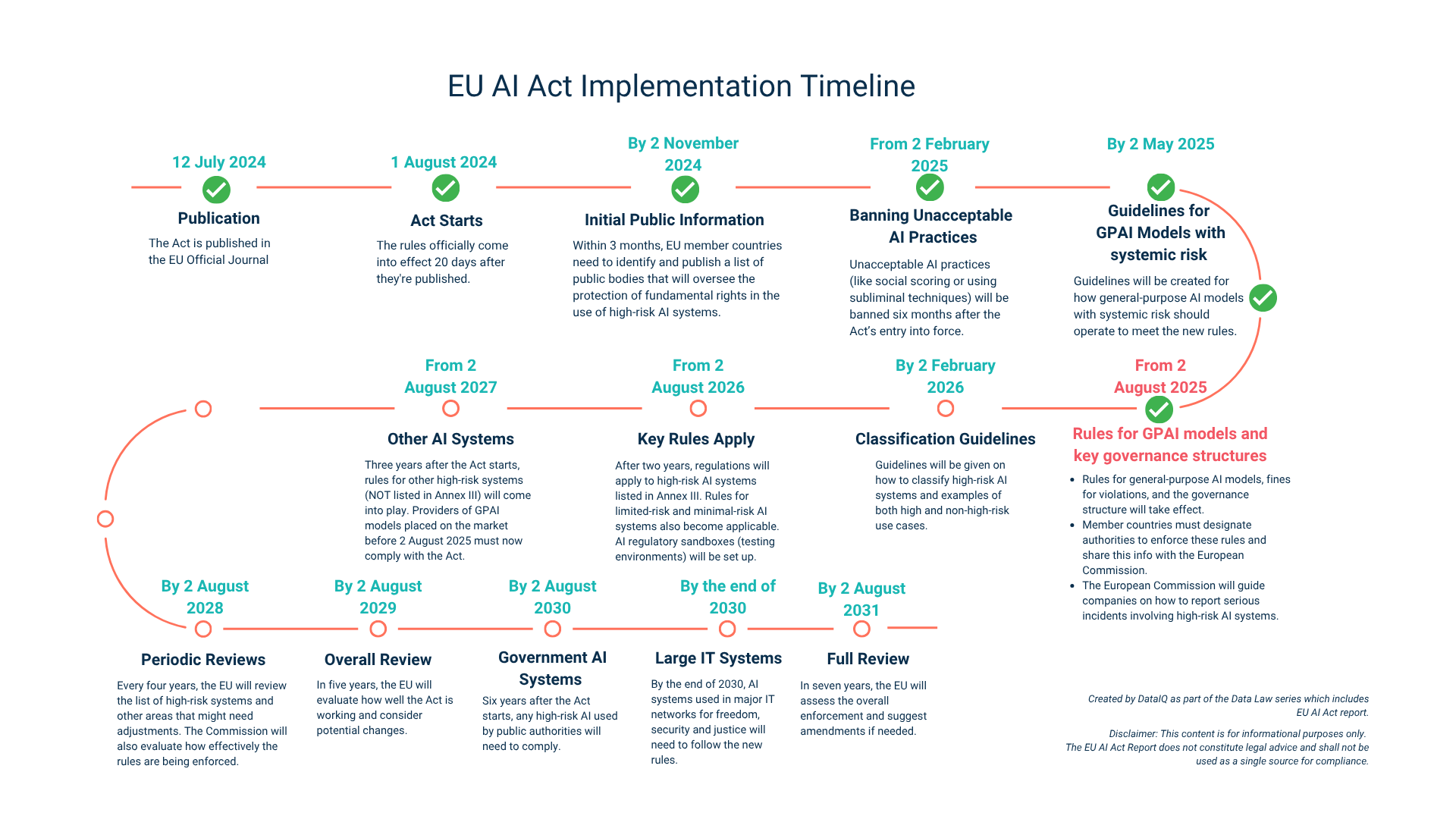Notable rules for the EU AI Act include:
- Governance infrastructure is now activated: all EU member states must have appointed national competent authorities (including notifying bodies and market surveillance authorities), reported them to the European Commission, and enacted penalties regimes consistent with Article 99 and 100.
- Binding obligations for General-Purpose AI (GPAI) providers come into force: providers must comply with Chapter V including transparency duties (training data summaries, technical documentation), risk-mitigation, and copyright compliance.
- Penalties now apply for GPAI providers: violations such as missing documentation or lack of transparency may incur fines up to €15 million or 3 % of global turnover; more serious offences, such as misleading authorities, could reach the top-tier €35 million or 7 % threshold later.
Guidelines and full definitions for GPAI Models can be found here.
What this means for EU‑based data and AI leaders
- If your organisation provides or modifies GPAI models, you must:
- Have in place governance frameworks for documentation, transparency, copyright checks, and incident reporting.
- Interact with notified bodies and provide evidence of compliance upon request.
- Use the EU’s formally published template for training data summary and technical documentation.
- Governance and enforcement readiness: national supervisory authorities must now be fully operational, including publicly listing contacts and reporting annual resourcing levels to the Commission.
Please note, there is still no grace period or delay. Despite calls from EU businesses and tech firms for postponement, the Commission has reiterated that the timeline stands.
If you only deploy or operate AI systems (not providers), your next critical milestone is 2 August 2026, when rules for high‑risk systems come into force, including formal conformity assessments, post‑market monitoring, and human oversight obligations.
Peter Galdies, Director, DataIQ: “As organisations enthusiastically embrace all the substantial benefits that AI services and products can bring it may be easy for them to overlook their responsibilities to ensure that such processing is not only with these regulations but also meets their more general ethical and sustainability values. It is possible for most organisations to balance these well, but the current scale and pace of adoption can cause priorities to become misaligned.”

What about the UK?
The UK is not subject to the EU AI Act, but many organisations will still need to comply if they have operations, users, or data subjects in the EU.
As non‑EU providers, UK entities offering GPAI into the EU must appoint an EU-based authorised representative and adhere to the same governance, transparency, and documentation obligations from 2 August 2025 onward.
For UK data and AI leaders, it is critical to determine whether you fall under EU jurisdiction as a provider, modifier, deployer or authorised representative, even if based outside the EU.
What should data and AI leaders be doing now?
|
Area |
EU‑based firms |
UK‑based firms |
|
Role assessment |
Confirm if you count as a GPAI provider or modifier. If yes, Chapter V compliance is mandatory from 2 August 2025. |
Confirm if you’re providing into the EU. If so, appoint EU authorised representative and comply with GPAI rules. |
|
Documentation |
Implement transparency docs, train‑data summaries (using EU template), risk‑mitigation processes and internal governance policies. |
Mirror the same requirements if serving EU users: redundancy helps if UK introduces own regulation. |
|
Compliance infrastructure |
Engage with notified bodies and prepare for possible audits or inspections. |
Monitor how UK regulation evolves. It will likely align but may diverge over time. |
|
Training & literacy |
Ensure AI literacy obligations are embedded (eg, staff training aligned with Article 4). |
Also advisable as a best practice and potential future UK law alignment. |
Enforcement readiness is real, and it is important. Governments and EU AI Office are launching oversight functions and penalties will be applied immediately for GPAI non‑compliance starting from 2 August 2025.
Data and AI leaders need to emphasise that GPAI is very rarely optional, becoming even more true for advanced models that meet the systemic risk thresholds. Transparency and model documentation are not simply bureaucratic: these are now legal obligations.
The bottom line is that EU‑based leaders must be fully compliant as of 2 August 2025 if they’re providers or modifiers of GPAI, and UK‑based firms must act as EU‑representatives and mirror these obligations if they serve EU markets. It is down to data and AI leaders to ensure strict compliance and organisation-wide understandings of these new obligations.





